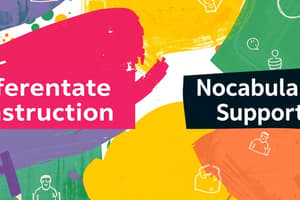Podcast
Questions and Answers
Match the concepts related to instructional support with their descriptions:
Match the concepts related to instructional support with their descriptions:
Concept Development = Encouraging creativity and discovery in children Quality of Feedback = Providing responses that aid student understanding Language Modeling = Demonstrating language use for effective communication Brainstorming = Generating ideas collaboratively for a project
Match the activities with their corresponding instructional strategies:
Match the activities with their corresponding instructional strategies:
Changing dramatic play area = Promoting imaginative play and conceptual thinking Asking wondering questions = Encouraging critical thinking about the world Connecting to real-world examples = Enhancing relevance and understanding of content Using meal times for discussions = Integrating learning with everyday experiences
Match the type of questions with their purpose:
Match the type of questions with their purpose:
How questions = Encouraging exploration of processes Why questions = Stimulating reasoning skills Where questions = Fostering geographical awareness What questions = Promoting recall of information
Match the locations with their relevance to the examples used in the classroom:
Match the locations with their relevance to the examples used in the classroom:
Match the supportive actions with their instructional benefits:
Match the supportive actions with their instructional benefits:
Match the educational focus with its corresponding age group:
Match the educational focus with its corresponding age group:
Match the strategies with their goals:
Match the strategies with their goals:
Match the characteristics of effective instructional approaches with their outcomes:
Match the characteristics of effective instructional approaches with their outcomes:
Study Notes
Concept Development in Instructional Support
- Concept development is a key dimension of instructional support that enhances the learning environment.
- Dimensions of concept development include quality of feedback and language modeling.
Effective Educational Strategies
- Preschool educators can adopt effective strategies to optimize instructional approaches.
- Emphasizing creativity and discovery fosters natural engagement during art and science activities.
Implementation of Concept Development
- Encourage children to fully engage in creative processes by allowing time for brainstorming, planning, and execution.
- Transformation of play spaces (e.g., changing a kitchen area to a zoo) promotes hands-on learning and collaboration.
Inquiry-Based Learning
- Use open-ended questions (how and why) to stimulate critical thinking and curiosity in children.
- Example questions like, "How do you think that hole got there?" or "Why do we have vegetables at lunch?" drive exploration of the world around them.
Real-World Connections
- Utilize everyday situations, like meal times, to connect children's learning to the real world.
- Discussing the origins of food (e.g., apples from orchards) helps children understand the broader context of their experiences.
Fostering a Love of Learning
- Concept development aims to ignite enthusiasm for learning, encouraging children to expand upon their existing knowledge and experiences.
- Create an enriching learning environment that nurtures curiosity and engagement in young learners.
Studying That Suits You
Use AI to generate personalized quizzes and flashcards to suit your learning preferences.
Description
Explore the first dimension of instructional support: concept development, quality of feedback, and language modeling. This introduction provides effective strategies for preschool educators to enhance their teaching methods and improve learning outcomes for young children. Watch a video to learn more about optimizing instructional approaches.




